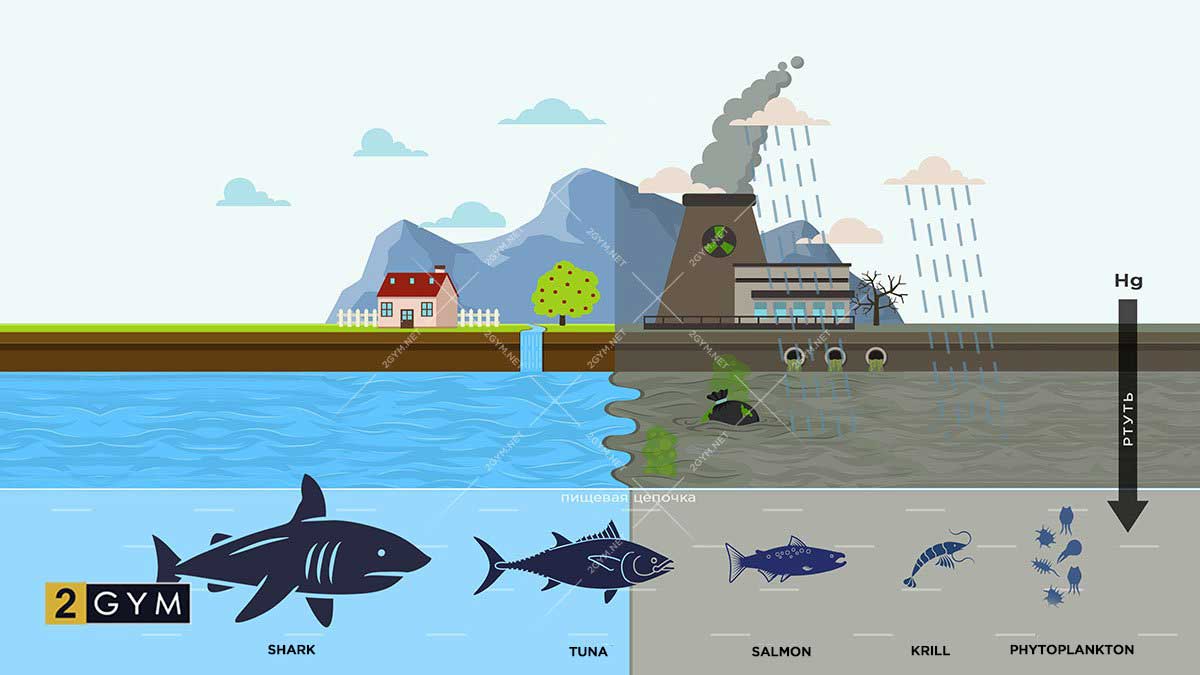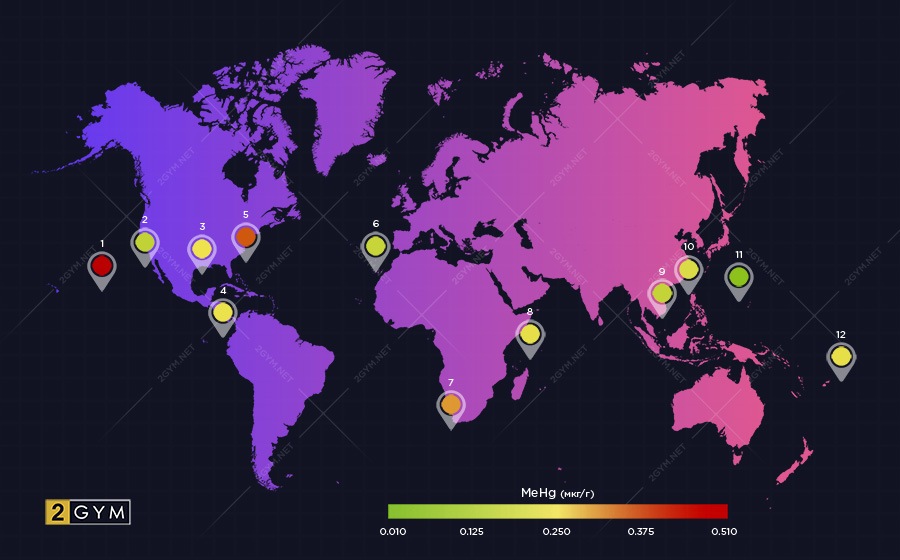Mercury in Fish
The thing is, practically all inhabitants of the ocean depths are capable of accumulating mercury (Hg), methylmercury (MeHg), as well as other potentially hazardous substances in their tissues.
I'll focus "on mercury", explaining what, why, and which fish is better to eat! In the current conditions of aggressive environmental and food situations, the information presented in this article is a contribution to the complex of measures aimed at optimizing the diet and, consequently, minimizing toxic factors.
This issue is undoubtedly relevant for everyone, but it is even more important for children, pregnant women, and nursing mothers.
How Dangerous is Mercury?

According to the 2005 report from the Centers for Disease Control and Prevention, every 17th American woman of childbearing age had a mercury level above 5.8 µg/L, which could harm the developing fetus.
The impact of mercury on the body during the prenatal period or while breastfeeding can have a significant negative effect on the baby's health.
Even in small doses, mercury can hinder a child's development, lead to decreased attention span, and learning difficulties.
Mercury is a so-called "heavy metal" that is toxic to living organisms, including being a neurotoxin, meaning it affects nerve tissue.
The presence of mercury in an adult's body can cause severe fatigue, neuro-muscular dysfunction, decrease fertility, mental abilities, and neurodegenerative diseases.
Mercury accumulates in tissues and is eliminated from the body very slowly. Studies show that the presence of mercury in the body is associated with neurological, immunological, and endocrinological disorders.
Including fish in the diet is recommended to increase omega-3 levels, however, seafood containing high levels of mercury may be hidden factors of hypertension.
Fish is often included in the diet as a symbol of a healthy lifestyle, but this is not always the case.
Where Does Mercury in Fish Come From?
The main source of environmental mercury pollution is industry, in the technological processes of which there is a link involving the combustion of organic fuels. For example, coal-fired power plants.

Power plants running on organic fuel are currently the main type of electricity production in many countries.
Other industrial sectors also contribute to the increase in mercury in the biosphere, however, it is believed that thermal power plants are the main source of pollution.
Mercury enters the hydrosphere either with precipitation or directly through sewage channels, after which it is transformed by bacteria into a particularly dangerous form called methylmercury.
What is Methylmercury?
Methylmercury (MeHg) is a highly toxic compound that can cause severe damage to the central nervous system. It is more toxic than mercury.
Mercury transforms into methylmercury through the metabolism of anaerobic bacteria, which is an even bigger ecological problem, as MeHg is even more toxic and requires more time to be completely eliminated from the body.
But there is good news: the amount of toxic substances, including mercury compounds, varies depending on the type of animal.
Which Fish Contains the Least Mercury?
Remember at the beginning of the article I mentioned "big and small fish"? Actually, the size of the animal can be one of the indirect criteria for choosing. For example, the concentration of mercury in the body of a shark will generally be much higher than in krill meat.
To understand which "fish" has a greater potential for mercury accumulation and which has less, let's consider the mechanism that determines the level of bioaccumulation of toxic substances in the bodies of aquatic organisms.
To view full screen, click on the image
Methylmercury, dissolved in water, is transferred through the food chain. It all starts with the toxic substance entering phytoplankton. Phytoplankton is consumed by zooplankton, which in turn is eaten by small fish, and then the small fish are eaten by larger inhabitants of the hydrosphere.
Each subsequent link in the food chain accumulates more mercury than representatives of the lower link. Therefore, large predatory fish, occupying the highest step of the food chain, such as sharks, swordfish, and bigeye tuna, pose the greatest danger in terms of the concentration of hazardous substances in their flesh.
Thus, predatory fish fall into the group of potential risk, as they often simply do not have time to eliminate methylmercury and other dangerous compounds from their bodies.
I want to emphasize that the size of the fish is still an indirect and not the main indicator of potential risk. Yes, predators, which occupy the highest level of the food chain, are generally larger. And yes, the size of an individual can tell about the age of the fish.
The larger the fish, the higher the likelihood that its body will contain a high level of methylmercury. However, I believe that when choosing a more environmentally friendly product, the size of the animal should not be considered as the only criterion.
Geographical Origin of Fish
The issue of environmental pollution is acute worldwide. However, there is an understanding that there are relatively clean regions on Earth, as well as places on the brink of catastrophe.
I think it's obvious to many that the level of toxic substances in the bodies of fish, shellfish, and other animals depends on their habitat.
- Mercury levels of yellowfin tuna (Thunnus albacares) are associated with capture location Sascha C T Nicklisch
-
The authors of this study came to a quite logical conclusion: the level of mercury depends on where the fish was caught. Nicklisch and colleagues examined mercury levels in 117 yellowfin tunas caught in 12 different locations around the world.The data showed significant differences in the content of methylmercury in yellowfin tuna, with levels ranging from 0.03 to 0.82 µg/g of raw weight in individual fish. Average mercury levels were weakly correlated with fish size or lipid content but varied significantly (8 times) depending on the catch location.
The results of this study show that the geographical origin of fish can affect mercury content.
Fig. Geographical differences in methylmercury content in yellowfin tuna meat
Click on the image to expand to full screen
The table below lists the average values of total mercury (Hg) and methylmercury (MeHg) content in µg/g of raw weight of yellowfin tuna caught in 12 different parts of the world. Also provided are the average standard values of the length of the caught fish (cm) and the average values of lipid (fat) content in the muscles (%).
Table 1. Mercury content in yellowfin tuna
| No. | Color | Geo | Hg, µg/g | MeHg, µg/g | Fish Length, cm | Lipids, % |
| 1 | Pacific Ocean | 0.602 | 0.506 | 117 | 1.52 | |
| 2 | Pacific Ocean | 0.154 | 0.164 | 55 | 3.25 | |
| 3 | Gulf of Mexico | 0.230 | 0.246 | 103 | 1.23 | |
| 4 | Pacific Ocean | 0.297 | 0.238 | 71 | 1.23 | |
| 5 | Atlantic Ocean | 0.430 | 0.345 | 92 | 0.41 | |
| 6 | Atlantic Ocean | 0.206 | 0.199 | 80 | 6.08 | |
| 7 | Atlantic Ocean | 0.348 | 0.308 | 84 | 2.76 | |
| 8 | Indian Ocean | 0.245 | 0.236 | 97 | 0.60 | |
| 9 | South China Sea | 0.181 | 0.160 | 109 | 1.09 | |
| 10 | East China Sea | 0.269 | 0.224 | 96 | 0.71 | |
| 11 | Pacific Ocean | 0.064 | 0.064 | 100 | 0.68 | |
| 12 | Pacific Ocean | 0.239 | 0.234 | 108 | 0.62 |
High levels of toxic substances (not only mercury) have been recorded in fish caught near industrially developed regions, for example, in waters adjacent to North America.
The table provides average values, but it is worth noting that among individual fish, methylmercury levels differed by 26 times. In addition, yellowfin tuna caught off the coast of North America and Europe contained on average 36 times more other toxic substances than specimens caught in more remote locations.
Differences between individual fish were much greater, as toxicity levels varied by 180 times among samples!
Relatively clean fish were found to be caught off the coasts of Asia and around the islands of the Pacific Ocean.
Dynamic sources of both natural and anthropogenic mercury contribute to the increase in mercury content in the environment. Two of the most polluted areas were relatively distant from terrestrial human impact sources, including markers on maps No. 1 and No. 12.
However, these areas may be downwind from atmospheric mercury sources originating from Asia, and, according to estimates, more than half of current global anthropogenic mercury emissions originate from the Asian continent.
In addition, given their proximity to volcanic activity, these areas may have additional natural sources of mercury.
Link to the study: Mercury levels of yellowfin tuna are associated with capture location
Today, it is believed that the most environmentally favorable regions for fish habitat are the waters of the Arctic, Antarctica, and Alaska.
Table of mercury content in fish and seafood
Below is a table of mercury content in different types of fish and shellfish in descending order of concentration. The data is taken from authoritative sources:
- Food and Drug Administration (FDA) - US Food and Drug Administration
- National Marine Fisheries Service (NMFS) - US National Marine Fisheries Service
Supplementary Information
Mackerel* - a general term for many species of fish, mainly from the family Scombridae (mackerel, bonitos, and others).
In the post-Soviet countries, the trade name "mackerel" refers to all types of fish from the Scombridae family, except for Atlantic mackerel, which is marketed as "mackerel". Also, "mackerel" is often sold under the name "bonito", misleading consumers.
Table 2. Mercury content in fish
1 data taken from Russian Journal of Marine Biology 41(6):479-484 2 includes: snow crab, blue crab, king crab 3 includes: yellowfin sole, starry flounder, rock solePink salmon. The content of all metals (except zinc) in pink salmon from the extreme geochemical region of the Kuril region was higher than in pink salmon from the Sea of Japan. The greatest difference was recorded for lead, the concentration of which in the organs and tissues (liver, gonads, muscles) of fish from the waters near the Kuril Islands was 15-45 times higher than that of pink salmon from the Sea of Japan. Source: www.researchgate.net
| Name | Average mercury concentration, mg/kg |
| Tilefish | 1.123 |
| Swordfish | 0.995 |
| Shark | 0.979 |
| King mackerel * (Gulf of Mexico) |
0.730 |
| Bigeye tuna | 0.689 |
| Atlantic bluefish | 0.571 |
| Marlin | 0.485 |
| Spanish mackerel * (Gulf of Mexico) |
0.454 |
| Grouper | 0.448 |
| Tilefish blue grenadier | 0.361 |
| Longtail tuna | 0.358 |
| Yellowfin tuna | 0.354 |
| Chilean sea bass | 0.354 |
| White croaker (Pacific Ocean) | 0.287 |
| Halibut | 0.241 |
| Sea trout | 0.235 |
| Grey mullet | 0.235 |
| Scorpionfish | 0.233 |
| Spanish mackerel * (South Atlantic) | 0.182 |
| Dolphin fish / Mahi-mahi | 0.178 |
| Striped and black bass | 0.167 |
| Snapper | 0.166 |
| Lobster | 0.166 |
| European eelpout / Sea raven | 0.161 |
| Perch | 0.150 |
| Striped tuna | 0.144 |
| Tilefish (Atlantic) | 0.144 |
| Skate | 0.137 |
| Buffalo fish | 0.137 |
| Sea bass | 0.121 |
| Cod | 0.111 |
| Carp | 0.110 |
| Black pike | 0.095 |
| North American lobster | 0.093 |
| Cape Cod flounder | 0.090 |
| Smelt | 0.089 |
| Pacific mackerel * | 0.088 |
| Haddock | 0.079 |
| Herring | 0.078 |
| Brook trout | 0.071 |
| Pink salmon 1 (Kuril Islands) | 0.070 |
| Atlantic croaker | 0.069 |
| Crab 2 | 0.065 |
| Sea bass | 0.058 |
| Flounder 3 | 0.056 |
| Plaice (Atlantic) | 0.055 |
| Pollock / whiting | 0.051 |
| Mullet | 0.050 |
| Mackerel / Atlantic mackerel * (North Atlantic) | 0.050 |
| American shad | 0.038 |
| Crayfish | 0.033 |
| Haddock | 0.031 |
| Alaska pollock | 0.031 |
| Squid | 0.024 |
| Catfish | 0.024 |
| Salmon | 0.022 |
| Anchovy | 0.016 |
| Tilapia | 0.013 |
| Sardine | 0.013 |
| Oyster | 0.012 |
| Shrimp | 0.009 |
| Blue mussel | 0.009 |
| Sea scallop | 0.003 |





















Log in with ( Sign Up ? )
or post as a guest
Be the first to comment.